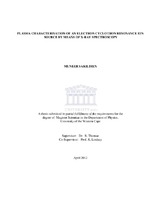| dc.description.abstract | The ultimate aim of any multiply-charged ion source, like the Electron Cyclotron Resonance Ion Source, ECRIS, is the production of multiply-charged ions, in sufficiently large quantities. These multiplycharged ions, in the case of the ECRIS, are created by a step-by-step ionisation process, whereby neutral atoms are ionised by energetic electrons. The goal of this thesis was to gain an understanding of the relative importance of various ECRIS parameters on the production of these energetic electrons. This was done by measuring the bremsstrahlung continuum emitted by the mirror confined plasma of an ECR ion source. The focus of our study was to investigate the influence of neutral pressure, incident microwave power and magnetic field configuration on spectral temperature and electron density of the warm electron population of the ECRIS plasma. The thesis begins by familiarising the reader with various aspects of plasma physics as it relates to the measurements. The measurements were done with a high-purity germanium detector and processed with the DGF Pixie-4 module. Analyses of the measured spectra were done with subroutines written in Root. From the measured result, it was concluded that by increasing the incident microwave power from 50 W to 300 W, the spectral temperature increases by 14.01% for helium plasma and 7.88% for argon plasma. Evidence of saturation of spectral temperature and electron density with increasing microwave power was also noticed, as reported by other groups investigating plasma bremsstrahlung. The increase of spectral temperature with neutral pressure was found to be considerable, increasing by 20.23% as the neutral pressure in the plasma chamber of the ECRIS was decreased. This increase in spectral temperature was accompanied by a 40.33% decrease in electron density, which led us to conclude that the increase in spectral temperature was most likely due to an increase in the mean free path of the electrons.
The influence of the magnetic field configuration on both spectral temperature and electron density was also investigated. During this investigation, one of the solenoid coil currents was increased, whilst keeping the other constant. This amounts to moving the plasma volume around axially in the plasma chamber of the ECRIS. This was found to significantly enhance the spectral temperature and this effect was attributed to more efficient heating of the electrons near the resonance zone. The electron density on the other hand was found to remain relatively constant, if one excludes the electron density as a result of one particularly setting of the solenoid coils. The decrease of electron density as a result of this particular setting of the solenoid coils enhanced the electron losses through the magnetic bottle. This is evidenced by the increase in photon counts as measured by our detector. The influence of neutral pressure, incident microwave power and magnetic field configuration on the extracted ion beam intensities was also investigated. This investigation led us to conclude that the mean charge state extracted increases with spectral temperature. This result was in agreement with those measured by other groups. | en_US |

